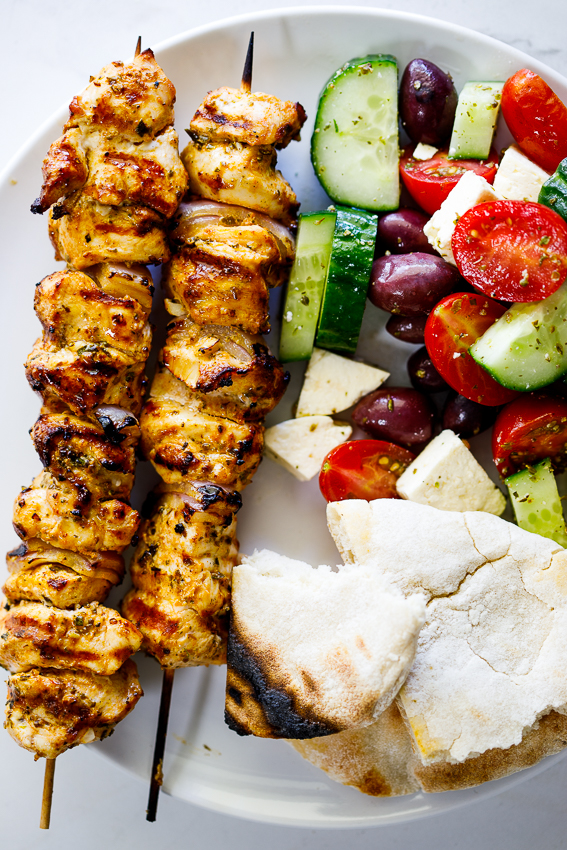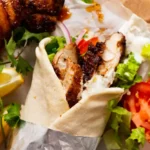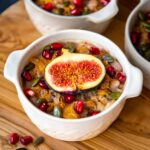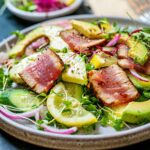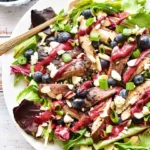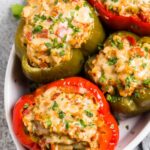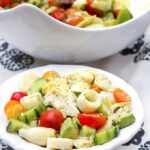Turkish cuisine offers a vibrant array of flavors and textures that can transport your taste buds straight to the heart of the Mediterranean. Each dish is crafted with fresh ingredients, aromatic spices, and age-old recipes passed down through generations. Whether you are new to Turkish food or a long-time fan, there’s always something new and exciting to discover.
Why explore Turkish recipes? These meals not only taste incredible but often are simple to prepare, making them perfect for home cooks of all skill levels. From savory stews to refreshing salads, Turkish food is a great way to bring a bit of international flair to your kitchen.
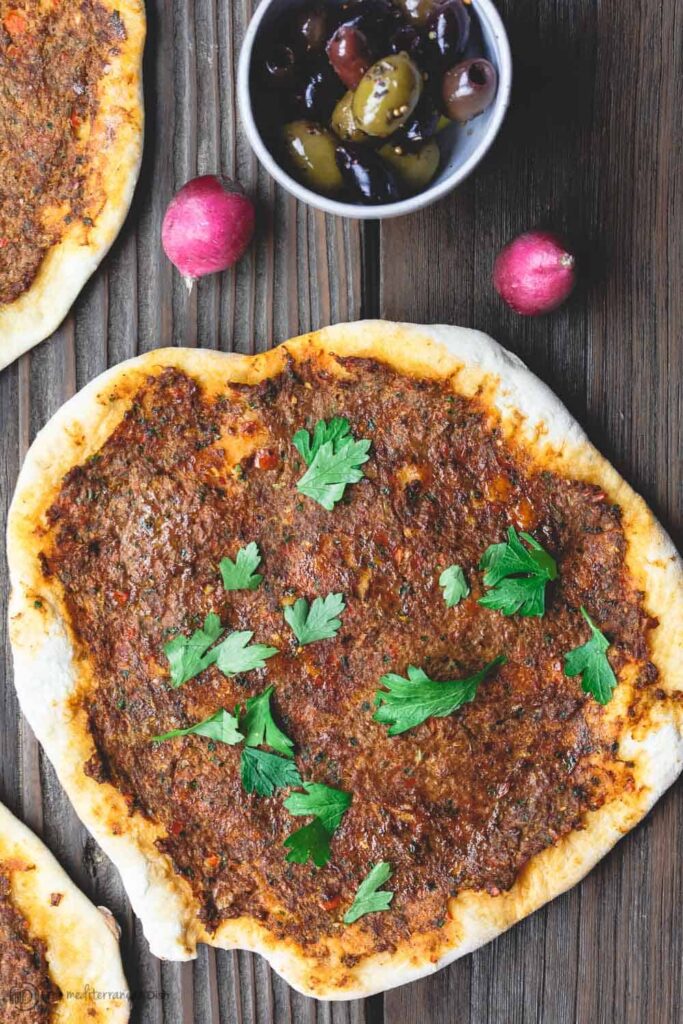
1) Lahmacun
Lahmacun, often called “Turkish pizza,” is a delicious and popular dish in Turkey. It features a thin and crispy flatbread topped with a flavorful mixture of minced meat, vegetables, and spices.
To prepare the dough, combine fresh or dry yeast with warm water, all-purpose flour, and a bit of salt. Knead the mixture until you get a soft, elastic dough. Let it rest for about an hour.
For the topping, use a food processor to finely chop red peppers, shallots, garlic, and parsley. Add minced meat, usually lamb or beef, and spices like paprika, cumin, and salt. Mix until well combined.
Preheat your oven to 450 degrees Fahrenheit and set the rack to the middle position. Roll the dough into thin rounds and spread the meat mixture evenly over each piece. Bake for 8-10 minutes until the edges are crispy.
Some people prefer cooking lahmacun on a stovetop. Heat a pan over medium-high heat and cook each flatbread for a few minutes on each side until done.
Serve lahmacun hot, often with a squeeze of lemon juice and a sprinkle of fresh parsley. It’s typically enjoyed with a side of salad, making for a perfect quick meal.
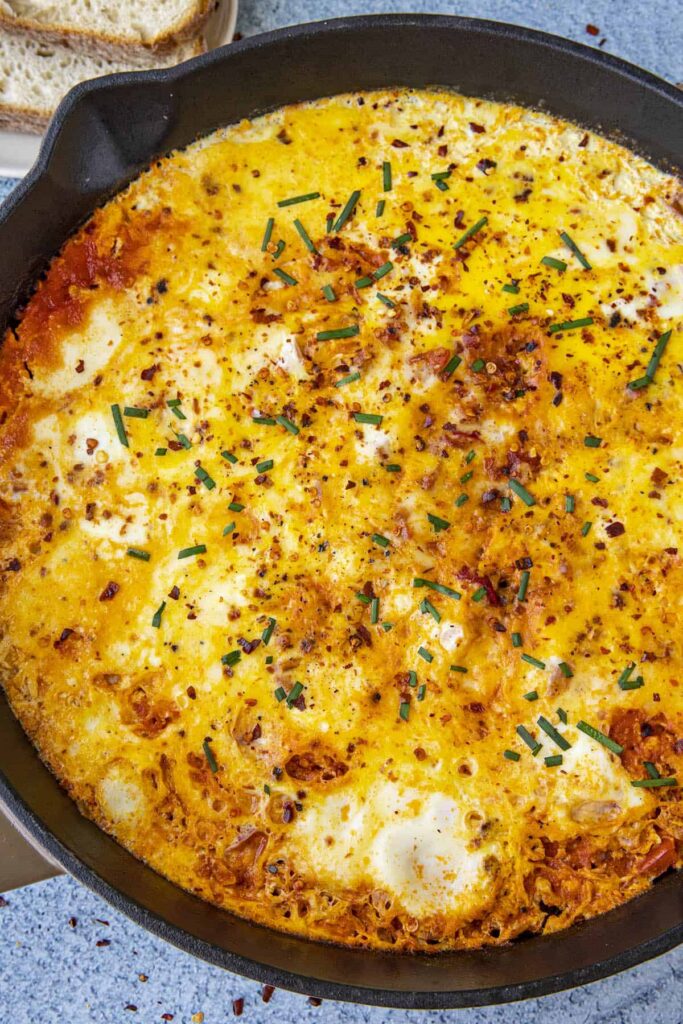
2) Menemen
Menemen is a classic Turkish breakfast dish made with eggs, tomatoes, peppers, and onions. It’s simple to make and full of flavor.
Start by heating oil in a skillet over medium heat. Add diced onions and cook until they become soft and translucent. This usually takes about 7 to 9 minutes.
Next, add chopped peppers and continue cooking until they soften. This step adds a layer of sweetness and slight crunch to the dish.
Once the peppers are soft, add the tomatoes. Cook them until they break down into a thick sauce. This will take several minutes and you should stir occasionally.
In a separate bowl, beat the eggs. You can season them with salt and pepper for extra taste. Pour the eggs into the skillet with the tomato mixture.
Gently stir the eggs into the tomatoes until they are just set. This step ensures the eggs remain creamy and delicious.
For added flavor, you can garnish with fresh herbs like parsley. Menemen is best served hot, and you can enjoy it with crusty bread.
This dish is versatile and can be a great addition to any meal, not just breakfast. Its ingredients are simple but create a rich and satisfying flavor.
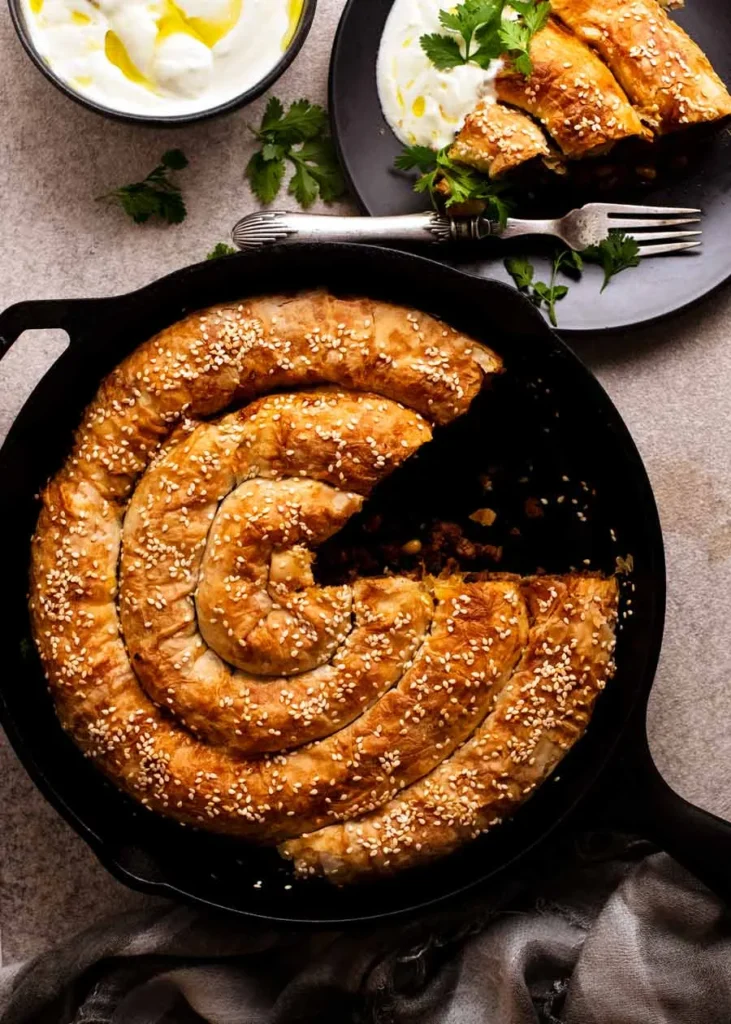
3) Börek
Börek is a popular Turkish pastry known for its delicate, flaky layers. It can be filled with various ingredients such as cheese, spinach, or meat.
Start by moistening your yufka dough by keeping it between two damp dish towels. This helps prevent it from drying out and cracking. Prepare your filling, whether it is cheese, spinach, or a combination.
Cut the yufka into the desired shape and layer it with the filling. Common shapes include triangles, rolls, or a large tray version. Brush the top with egg wash for a golden finish, and optionally sprinkle with sesame or nigella seeds.
Bake in a preheated oven until the top is golden brown. Let it cool for a few minutes before serving.
For a frying version like Sigara Börek, heat oil in a pan over medium heat. Fry the rolled böreks until crispy and golden. Place on a paper towel to absorb excess oil.
Börek can be enjoyed hot or at room temperature. It is a versatile dish perfect for breakfast, snacks, or as a part of a larger meal.
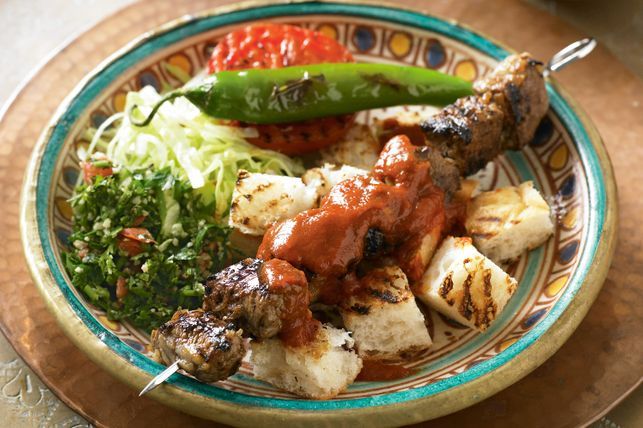
4) İskender Kebab
İskender Kebab is a popular Turkish dish known for its delicious flavors. This kebab features thinly sliced, cooked meat laid over pieces of pita bread.
First, marinate your meat. You can use lamb, beef, or steak. Marinate the meat with grated onions, olive oil, and oregano for a few hours.
Prepare the pita bread by lightly toasting it until crispy. Cut the toasted pita into bite-sized pieces and arrange them on a serving plate.
For the tomato sauce, heat olive oil in a saucepan. Add chopped tomatoes, tomato paste, garlic, and a pinch of salt and pepper. Let it simmer until the tomatoes soften and the sauce thickens.
When ready to serve, drizzle the hot tomato sauce over the toasted pita pieces. Place the warm, cooked meat on top of the pitas.
Add a generous dollop of thick yogurt on the side. Garnish with grilled tomatoes and peppers. Finish with a drizzle of melted butter over the entire dish.
Enjoy your İskender Kebab hot with your favorite sides.
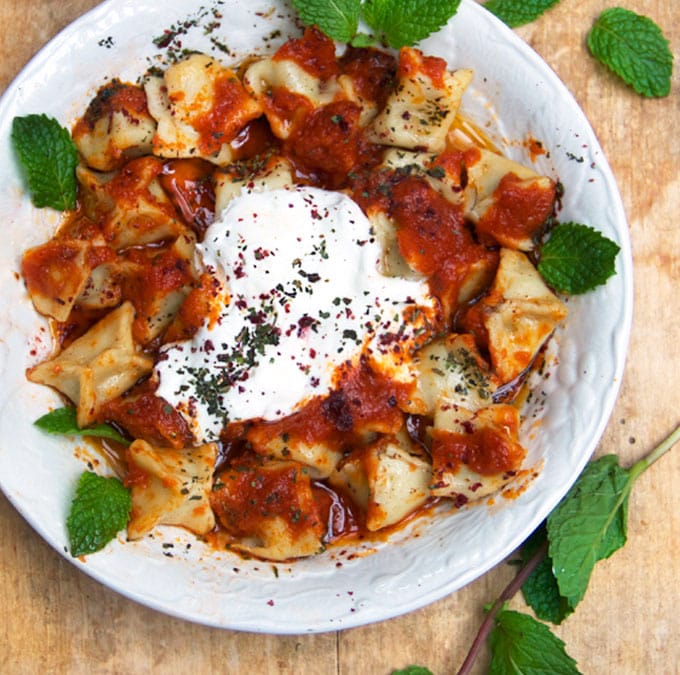
5) Manti
Manti are small Turkish dumplings filled with ground meat, usually beef or lamb, mixed with onions and simple spices like salt and pepper.
To make manti, you start by preparing the dough. Mix flour, water, eggs, and salt until smooth. Let it rest for about 30 minutes.
While the dough rests, prepare the filling. Combine ground meat, finely grated onion, salt, and pepper. Mix well until everything is mashed and fully combined.
Once the dough is ready, roll it out thin on a floured surface. Cut the dough into small squares, around half an inch each. Place a small amount of the filling in the center of each square.
Fold the edges of the dough squares inward, pressing the corners together to form a small pouch-like shape. Be sure they are sealed tightly to prevent any filling from leaking out.
Boil the manti in salted water until they float to the top, which usually takes a few minutes.
Serve your manti with a dollop of yogurt sauce made from yogurt, garlic, and salt. You can also drizzle melted butter mixed with paprika over the top for extra flavor.
Manti may be small, but they deliver a big taste and are a cherished dish in Turkish cuisine.
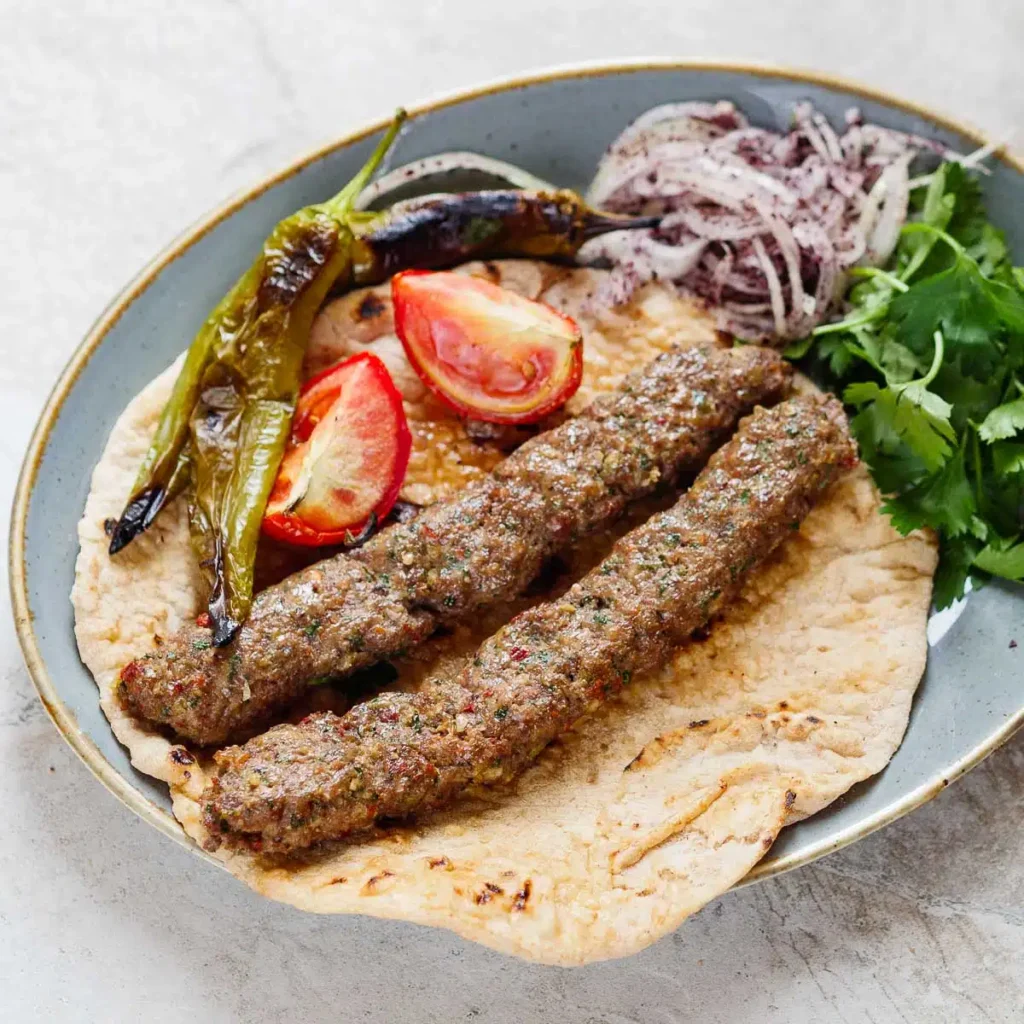
6) Adana Kebab
Adana Kebab is a popular Turkish dish made from ground lamb or beef. Named after the city of Adana, this kebab is known for its spicy flavor. You mold the meat onto skewers before grilling.
To prepare, mix ground lamb with minced onion, salt, paprika, black pepper, and cumin. Adding chili flakes and sumac gives it an extra kick. For richer flavor, include chopped tail fat or grated beef suet.
Knead the meat mixture until it becomes tacky and sticks together. Mold the meat onto flat skewers, pressing firmly to ensure it holds.
Preheat your grill to high heat. Place the skewers on the grill and cook for 5 minutes on each side. Keep an eye on them to avoid burning.
You can also cook Adana Kebab in the oven at 450°F for about 15-18 minutes. Turn on the broiler for the last few minutes to deepen the color.
Serve Adana Kebabs with flatbread, grilled vegetables, and a fresh salad. Onions with sumac and parsley make a great side dish.
This delicious, spicy kebab is sure to impress your family and friends. Enjoy!
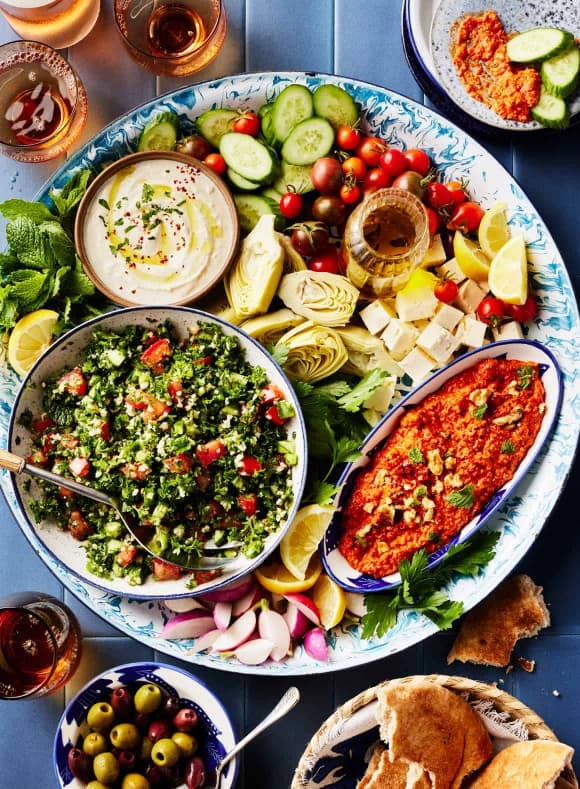
7) Meze Platter
A meze platter is a collection of small dishes served as appetizers. It’s a great way to experience a variety of flavors in one meal. You can start with roasted eggplant, drizzled generously with olive oil. This dish is simple yet flavorful.
Then, add fava, a bean puree that’s high in protein. Fava beans are mixed with olive oil and onions for a smooth, nutty taste.
No meze platter is complete without peppers. Roast them, then slice and season with garlic, vinegar, oregano, and sea salt. Sprinkle with parsley just before serving.
Hummus is a must-have. You can place two types of hummus on your platter for variety. Use chickpeas, tahini, lemon juice, and garlic to make it at home.
Include olives and feta cheese to add a salty bite. Both are traditional and easy to find.
Lastly, don’t forget to offer fresh bread for dipping. Turkish flatbread or pita works well.
Assemble these dishes on a large serving platter. They should be arranged to allow everyone to sample each dish easily.
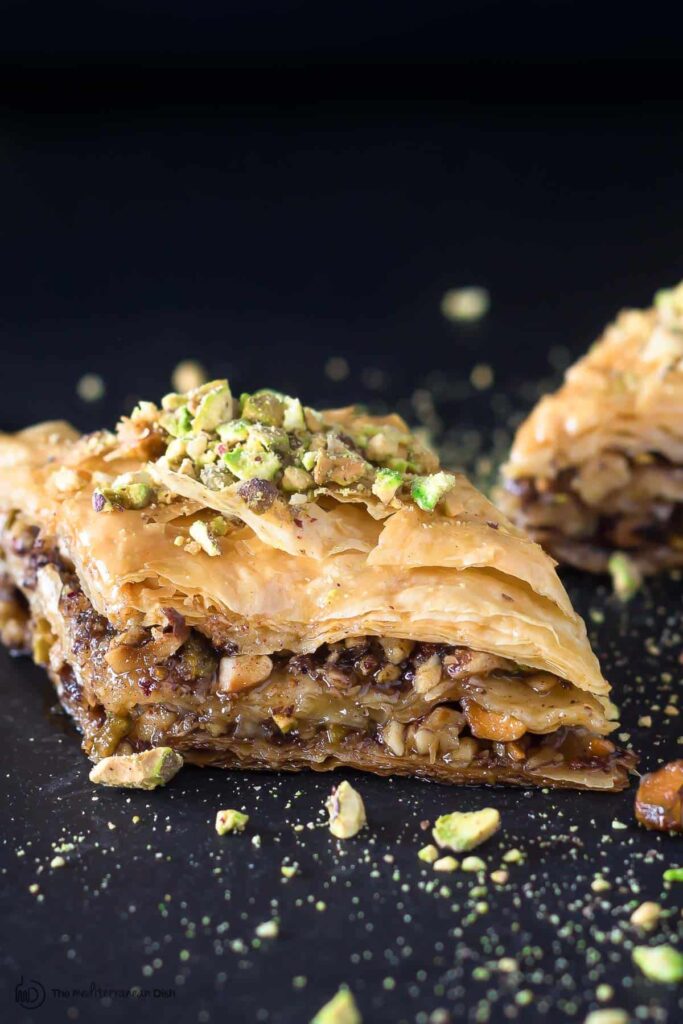
8) Baklava
Baklava is a sweet pastry made of layers of phyllo dough filled with chopped nuts and sweetened with syrup or honey. It is a popular dessert in Turkey and the Middle East.
To make baklava, start by preparing your filling. This usually includes finely chopped walnuts or pistachios. You can adjust the nut mixture to your liking.
Next, prepare your syrup. Combine sugar, water, and a few drops of lemon juice in a saucepan. Bring it to a boil and then let it simmer for about 5 minutes.
Preheat your oven to 350°F (175°C). Brush a 9×13-inch baking dish with melted butter. Lay a sheet of phyllo dough on the bottom of the dish and brush it with more butter. Repeat this process, layering the phyllo and butter, until you have about 8-10 layers.
Spread a thin layer of the nut mixture over the phyllo layers. Continue layering phyllo sheets and butter, occasionally adding more nuts, until all the ingredients are used up.
Cut the assembled baklava into diamond or square shapes before baking. Bake for about 35-40 minutes, or until the top is golden and crispy.
Once baked, immediately pour the warm syrup over the hot baklava, ensuring it seeps into all the layers. Allow it to cool completely before serving.
Baklava is best enjoyed at room temperature and can be stored in an airtight container for several days.
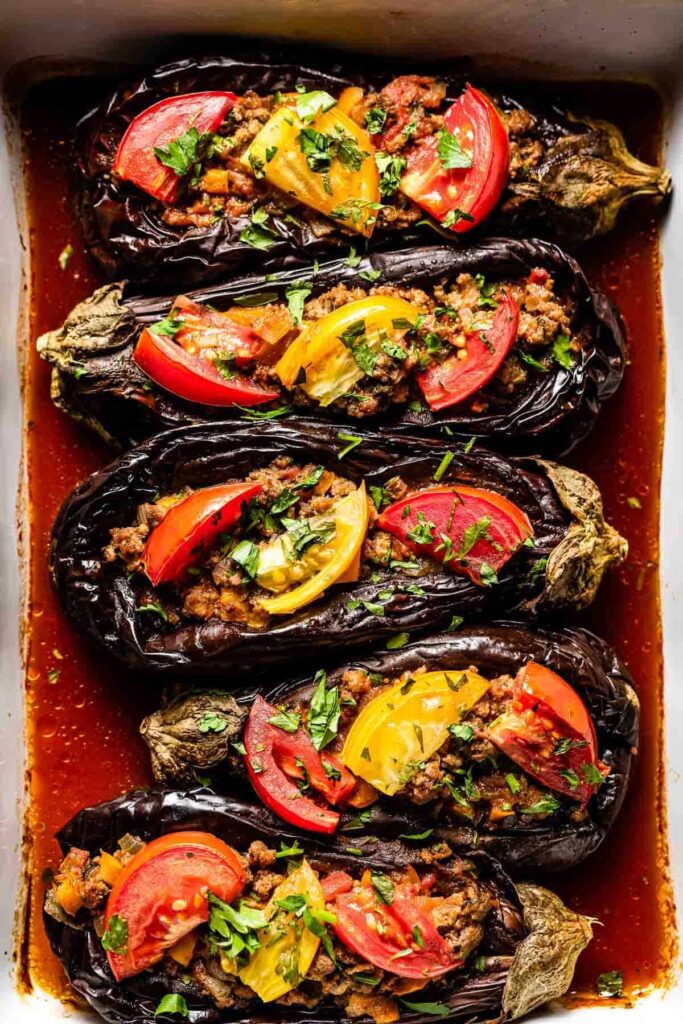
9) Karnıyarık
Karnıyarık is a classic Turkish dish featuring stuffed eggplants.
First, you need to preheat your oven to around 200 degrees Celsius. Prepare your eggplants by peeling strips of the skin to create a zebra pattern. Cut the eggplants in half lengthways while leaving the stalks intact. Make a deep slit in each half without cutting through the skin on the other side.
Before cooking, sprinkle salt on the eggplants and let them sit for about 10 minutes. This helps to remove any bitterness. Rinse the salt off and dry the eggplants well.
Next, sauté ground meat with onions until the meat is browned. Add tomatoes, salt, and pepper, and simmer for around 10 minutes. Mix in tomato paste and let it cool.
Now, create space in the eggplants by pushing the edges of the slits to form a boat shape. Fill each eggplant with the meat mixture, letting it mound through the slit. Place the stuffed eggplants in a baking dish.
Mix water and tomato paste together and pour it over the stuffed eggplants. Bake in the preheated oven for about 30 minutes, or until the eggplants are tender.
Serve your Karnıyarık hot with rice or yogurt on the side.
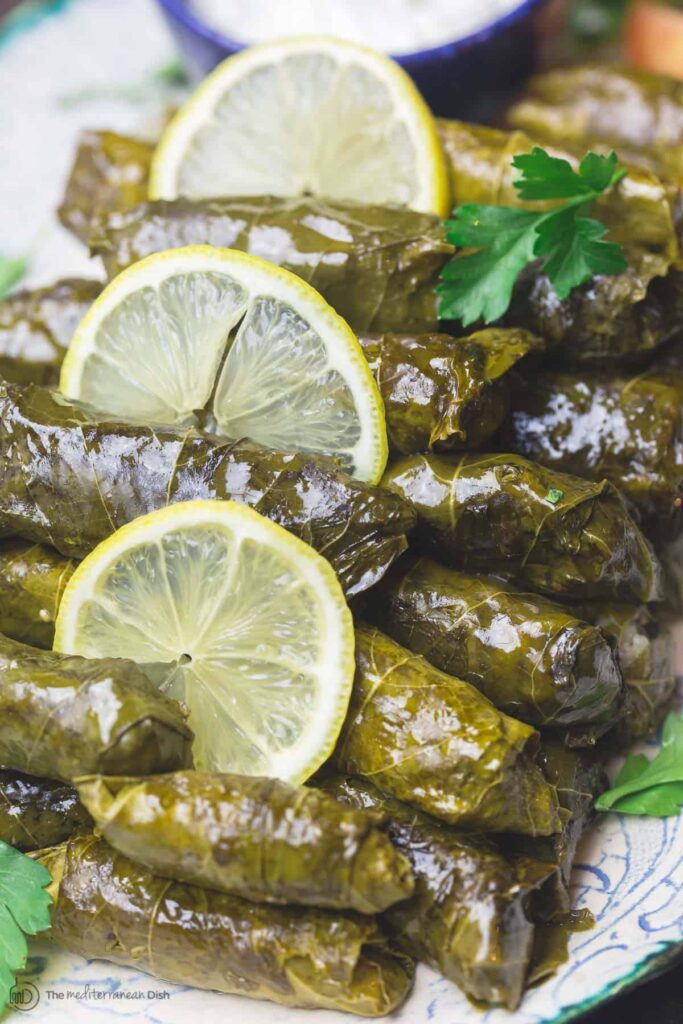
10) Dolma
Dolma is a famous Turkish dish known for its flavorful stuffing. It often includes grape leaves, peppers, or other vegetables filled with a mixture of rice, ground meat, and various spices.
To prepare dolma, begin by soaking grape leaves in hot water to soften them. If you use peppers or other vegetables, clean and core them first.
For the filling, mix raw ground meat, rice, chopped onions, and parsley. Season with salt, pepper, and other spices like cinnamon or allspice.
Stuff the vegetables or grape leaves with the meat and rice mixture. Leave a little space for the rice to expand during cooking. Place them snugly in a pot.
Prepare a cooking liquid with water, broth, or tomato sauce. Pour it over the stuffed vegetables until almost covered. Place a plate on top to keep them in place during cooking.
Bring the liquid to a boil, then reduce to a gentle simmer. Cover the pot and cook for about 30-45 minutes until the rice and meat are fully cooked.
Once done, let the dolma cool slightly before serving. You can add a squeeze of fresh lemon juice for extra flavor. Enjoy your delicious Turkish dolma!
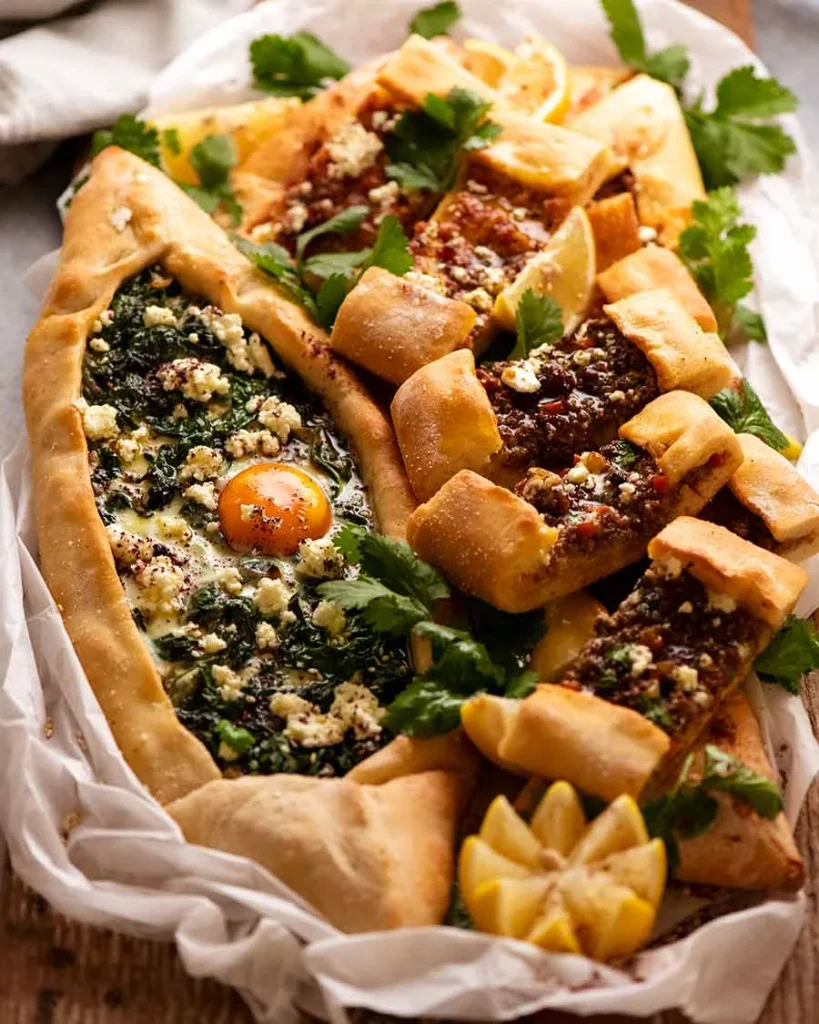
11) Pide
Pide, often called Turkish pizza, is a popular dish in Turkey. The dough is soft and slightly chewy, making it perfect for holding various toppings.
To make the dough, dissolve yeast in warm water with a bit of sugar. Then add flour, salt, and some oil. Knead until smooth.
Let the dough rest and rise for about an hour. Once ready, roll it out into an oblong shape.
For toppings, you can use cheese, spinach, Turkish sausage, or spiced lamb. Spread your chosen toppings on the dough, leaving a border for folding.
Preheat your oven to high heat, around 220°C (425°F). Bake the pide for about 15 minutes until the edges are golden and crispy.
Pide is best enjoyed fresh out of the oven.
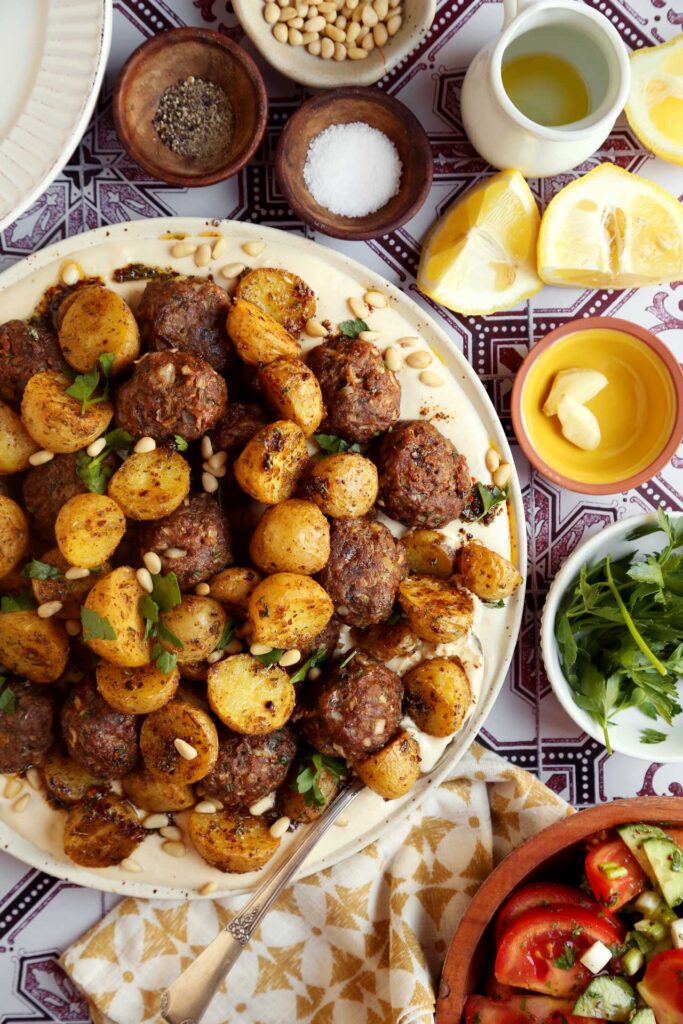
12) Köfte
Köfte is a popular Turkish meatball dish enjoyed by many. It is made from ground meat, typically beef or lamb, mixed with spices and herbs.
To prepare köfte, start by grating an onion and finely chopping parsley. Mix the ground meat with the grated onion, chopped parsley, and spices like black pepper, cumin, and red pepper flakes.
Add breadcrumbs and an egg to the mixture to help bind the ingredients. Knead the mixture well using your hands until everything is combined. Let the mixture rest in the refrigerator for about an hour.
After resting, shape the meat mixture into small balls or patties. You can make them flat and circular or in small cylindrical shapes.
Cook the köfte by grilling, baking, or frying until they are browned on the outside and cooked through inside.
Serve köfte with rice, salad, or flatbread for a delicious meal. They are also great with a side of yogurt or a squeeze of lemon juice.
Enjoy your köfte as part of a hearty and flavorful Turkish meal.
History and Origins of Turkish Cuisine
Turkish cuisine is a rich blend of flavors and textures, shaped by a variety of historical and cultural influences. Its evolution over centuries has created a unique culinary tradition that you can enjoy today.
Influences From Neighboring Regions
Turkish cuisine is greatly influenced by the geographical diversity of Turkey and the many cultures that surrounded it. Central Asian Turkic roots brought foods like yogurt and grilled meats.
The Persian Empire’s impact introduced new spices and rice dishes, adding depth to the flavors. As Turkey controlled the Silk Road, it also absorbed elements from cuisines in Asia, Europe, and the Middle East.
Evolution Over Centuries
Over centuries, Turkish cuisine evolved through interactions with the Byzantine and Ottoman Empires. The Ottomans, in particular, were known for their lavish dishes and use of numerous ingredients.
Modern Turkish dishes like dolma and kebabs can trace their origins back to these times. With time, new ingredients and cooking methods were adopted, helping to create the vibrant and diverse culinary landscape you see today.
Essential Ingredients in Turkish Cooking
In Turkish cuisine, specific spices, herbs, vegetables, fruits, proteins, and dairy play crucial roles. These ingredients give Turkish dishes their unique flavors and textures.
Spices and Herbs
Sumac is a common Turkish spice used to add a tangy, lemony flavor to dishes. It’s often sprinkled on kebabs and salads.
Cumin adds a warm, earthy taste, essential in many meat dishes and stews.
Baharat is a blend made from pepper, cumin, coriander, cinnamon, and more, used in various recipes, from soups to meats.
Mint and parsley are fresh herbs that frequently appear in salads, soups, and meat dishes, adding a refreshing taste.
Paprika and red pepper flakes give a mild to spicy heat, essential in dishes like kebabs and mezes.
Unique Vegetables and Fruits
Eggplants are a staple in Turkish cooking. Grilled, roasted, or stuffed, they are used in numerous dishes like Imam Bayildi.
Tomatoes and bell peppers are essential, often used in stews, salads, and sauces.
Grape leaves are used for wrapping fillings in sarma dishes. They add a slightly tangy taste to the food.
Zucchini is also a prevalent vegetable, often stuffed or used in fritters known as mücver.
Pomegranates are used for their juice and seeds. The seeds add a burst of flavor and texture to salads and desserts, while the juice is used in sauces.
Staple Proteins and Dairy
Lamb is a central protein in Turkish meals, often grilled, stewed, or used in kebab recipes.
Chicken is also popular, frequently marinated with spices and cooked on skewers.
Yogurt is a key dairy product, used in sauces, soups, and as a side. It provides a creamy texture and a subtle tang.
Feta cheese (known as beyaz peynir) is often crumbled over salads and pastries.
White beans are used in hearty stews, offering a nutritious and filling option.
Turkish Cooking Techniques
Turkish cuisine uses a variety of methods to create flavorful and aromatic dishes. The primary techniques include grilling and roasting, as well as slow cooking and braising, each lending a distinct texture and depth to the food.
Grilling and Roasting
Grilling is central to Turkish cooking, often done over an open flame. This method is used for kebabs, where meat is marinated with spices and skewered. Shish kebabs and Adana kebabs are popular examples. The high heat caramelizes the meat’s exterior, producing a smoky flavor while keeping the inside tender.
Roasting is equally significant, particularly for whole meats and vegetables. For instance, lamb roasts and roasted eggplants (patlıcan) offer deep, rich flavors. Roasting in traditional clay ovens or on open metal sheets ensures uniform cooking and a unique taste.
Slow Cooking and Braising
Slow cooking is vital for dishes that require tenderizing tough cuts of meat, like lamb and beef. Etli kuru fasulye, a meat and white bean stew, is slow-cooked to combine flavors and soften ingredients. This method allows spices and herbs to infuse thoroughly into the dish.
Braising combines searing with slow cooking in a small amount of liquid, often in a closed container. This is popular for dishes like karniyarik, stuffed eggplants, and tavuk yahni, a chicken stew. Braising locks in moisture and melds the diverse flavors, resulting in succulent and sumptuous meals.
